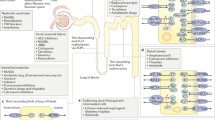Abstract
Among the cellular models used in in vitro renal pharmacotoxicology, isolated kidney tubules, used as suspensions mainly of proximal tubules, offer important advantages. They can be prepared in large amounts under nonsterile conditions within 1–2 h; thus, it is possible to employ a great number of experimental conditions simultaneously and to obtain rapidly many experimental results. Kidney tubules can be prepared from the kidney of many animal species and also from the human kidney; given the very limited availability of healthy human renal tissue, it is therefore possible to choose the most appropriate species for the study of a particular problem encountered in man. Kidney tubules can be used for screening and prevention of nephrotoxic effects and to identify their mechanisms as well as to study the renal metabolism of xenobiotics. When compared with cultured renal cell, a major advantage of kidney tubules is that they remain differentiated. The main limitations of the use of kidney tubules in pharmacotoxicology are (1) the necessity to prepare them as soon as the renal tissue sample is obtained; (2) their limited viability, which is restricted to 2–3 h; (3) the inability to expose them chronically to a potential nephrotoxic drug; (4) the inability to study transepithelial transport; and (5) the uncertainty in the extrapolation to man of the results obtained using animal kidney tubules. These advantages and limitations of the use of human and animal kidney tubules in pharmacotoxicology are illustrated mainly by the results of experiments performed with valproate, an antiepileptic and moderately hyperammonemic agent. The fact that kidney tubules, unlike cultured renal cells, retain key metabolic properties is also shown to be of the utmost importance in detecting certain nephrotoxic effects.
Similar content being viewed by others
References
Baverel G, Lund P. A role for bicarbonate in the regulation of mammalian glutamine metabolism. Biochem J. 1979; 184:599–606.
Baverel G, Bonnard M, d'Armagnacde Castanet E, Pellet M. Lactate and pyruvate metabolism in isolated renal tubules of normal dogs. Kidney Int. 1978;14:567–75.
Baverel G, Bonnard M, Pellet M. Lactate and pyruvate metabolism in isolated human kidney tubules. FEBS Lett. 1979;101:282–6.
Baverel G, Genoux C, Forissier M, Pellet M. Fate of glutamate carbon and nitrogen in isolated guinea-pig kidney-cortex tubules. Evidence for involvement of glutamate dehydrogenase in glutamine synthesis from glutamate. Biochem J. 1980; 188:873–80.
Bolon C, Chauvin MF, Simonnet H, Gauthier C, Baverel G. Growth of cultured rabbit renal tubular cells does not require exogenous glutamine. Kidney Int. 1995;47:299–305.
Burg MB, Orloff J. Oxygen consumption and active transport in seperated renal tubules. Am J Physiol. 1962;203: 327–30.
Chauvin MF, Megnin-Chanet F, Martin G, Lhoste JM, Baverel G. The rabbit kidney tubule utilizes glucose for glutamine synthesis. A13C NMR study. J Biol Chem. 1994;269:26025–33.
Dugelay S, Baverel G. Concomitant synthesis and degradation of glutamine in isolated rabbit kidney tubules. Biochim Biophys Acta. 1991;1075:191–4.
Durozard D, Baverel G. Gas chromatographic method for the measurement of sodium valproate utilization by kidney tubules. J Chromatogr. 1987;414:460–4.
Durozard D, Martin G, Baverel G. Valproate-induced alterations of coenzyme A and coenzyme A ester concentrations in human kidney tubules metabolizing glutamine. In: Endou H, Schoolwerth AC, Baverel G, Tizianello A, eds. Molecular aspects of ammoniagenesis. Basel: Karger; 1991:103–8. [Contrib. Nephrol. 92].
Elhamri M, Ferrier B, Martin M, Baverel G. Effect of valproate, sodium 2-propyl-4-pentenoate and sodium 2-propyl-2-pentenoate on renal substrate uptake and ammoniagenesis in the rat. J Pharmacol Exp Ther. 1993;266:89–96.
Ferrier B, Martin M, Baverel G. Valproate-induced stimulation of renal ammonia production and excretion in the rat. J Clin Chem Clin Biochem. 1988;26:65–7.
Fisher E, Wittfoht W, Nau H. Quantitative determination of valproic acid and 14 metabolites in serum and urine by gas chromatography/mass spectrometry. Biomed Chromatogr. 1992;6:24–9.
Fouque D, Dugelay S, Martin G, Combet J, Baverel G. Alanine metabolism in isolated tubules from human kidney cortex. Use of a mathematical model. Eur J Biochem. 1996;236:128–37.
Guder WG, Wiesner W, Stukowski B, Wieland O. Metabolism of isolated kidney tubules. Oxygen consumption, gluconeogenesis and the effect of cyclic nucleotides in tubules from starved rats. Hoppe Seyler's Z Physiol Chem. 1971;352: 1319–28.
Kvamme E, Torgner IA. The effect of acetyl-coenzyme A on phosphate-activated glutaminase from pig kidney and brain. Biochem J. 1974;137:525–30.
Martin G, Durozard D, Baverel G. Acceleration of ammoniagenesis in isolated rat kidney tubules by the antiepileptic drug: valproic acid. In: Kovacevic Z, Guder WG, eds. Molecular nephrology. Biochemical aspects of kidney function. Berlin: Walter de Gruyter; 1987:287–92.
Martin G, Michoudet C, Baverel G. Stimulation of glutamine metabolism by the antiepileptic drug, sodium valproate, in isolated dog kidney tubules. Biochem Pharmacol. 1989;38:3947–52.
Martin G, Durozard D, Besson J, Baverel G. Effect of the antiepileptic drug sodium valproate on glutamine and glutamate metabolism in isolated human kidney tubules. Biochim Biophys Acta. 1990;1033:261–6.
Michoudet C, Baverel G. Metabolism of acetaldehyde in human and baboon renal cortex. Ethanol synthesis by isolated baboon kidney tubules. FEBS Lett. 1987a;216:113–7.
Michoudet C, Baverel G. Characteristics of acetaldehyde metabolism in isolated dog, rat and guinea-pig kidney tubules. Biochem Pharmacol. 1987b;36:3987–91.
Rawat S, Borkowski WJ, Swick HM. Valproic acid and secondary hyperammonemia. Neurology. 1981;31: 1173–4.
Simon D, Penry JK. Sodium di-n-propylacetate (DPA) in the treatment of epilepsy: a review. Epilepsia. 1975;16: 549–73.
Sorrell MF, Tuma DJ. Effects of alcohol on hepatic metabolism: selected aspects. Clin Sci. 1979;57:481–9.
Tune BM, Wu KY, Fravert D, Holtzman D. Effect of cephaloridine on respiration by renal cortical mitochondria. J Pharmacol Exp Ther. 1979;210:98–100.
Warter JM, Imler M, Marescaux C et al. Sodium valproate-induced hyperammonemia in the rat: role of the kidney. Eur J Pharmacol. 1983;87:177–82.
Warter JM, Marescaux C, Chabrier G, Rumbach L, Micheletti B, Imler M. Métabolisme rénal de la glutamine chez l'homme au cours des traitements par le valproate de sodium. Rev Neurol (Paris). 1984; 140:370–1.
Author information
Authors and Affiliations
Rights and permissions
About this article
Cite this article
Chauvin, M.F., Bolon, C., Conjard, A. et al. Advantages and limitations of the use of isolated kidney tubules in pharmacotoxicology. Cell Biol Toxicol 12, 283–287 (1996). https://doi.org/10.1007/BF00438159
Accepted:
Issue Date:
DOI: https://doi.org/10.1007/BF00438159




